A Systematic Review of Innovative Advances in Multi-Material Additive Manufacturing: Implications for Architecture and Construction
Abstract
:1. Introduction
2. Materials and Methods
2.1. Database Selection and Search Strategy
2.2. Paper Selection Process
- Relevance to construction: Priority was given to papers discussing applications, materials, or techniques with potential relevance or adaptability to additive manufacturing in architecture and the construction industry.
- Material relevance: Studies discussing materials with potential construction applications were prioritized.
- Optimization focus: Papers presenting novel optimization methods for multi-material AM were selected.
- Scalability potential: Studies demonstrating potential for scaling up to construction-sized applications were chosen.
- Innovative optimization methods: Papers presenting approaches that can be adapted to construction-scale material extrusion processes, such as those discussing machine learning or artificial intelligence approaches.
- Novel design approaches: Studies showcasing design strategies with potential architectural applications, including those discussing finite-element analysis or topology optimization.
- Multi-functionality: Research focused on optimizing multiple properties simultaneously.
- Validation techniques: Studies employing advanced testing methods applicable to large-scale AM components.
2.3. Categorization and Analysis
- Manufacturing processes.
- Material distribution and combination.
- Design approaches.
- Optimization methods.
- Validation methods.
2.4. Bibliometric Analysis
3. Key Parameters Influencing MMAM Processes
3.1. Material-Related Parameters
3.1.1. Mechanical Properties
3.1.2. Thermal Properties
3.1.3. Scale-Dependent Properties
3.1.4. Main Material Combinations
3.1.5. Property Interrelations and Optimization Challenges
- Enhancing tensile strength might require changes in printing temperatures, subsequently impacting rheological behavior and thermal gradients within the printed parts [31];
- Managing differences in thermal expansion between materials requires trade-offs with processing temperatures or print speeds [32];
3.1.6. Applications of Material-Related Parameters in Architecture
3.2. Process-Related Parameters in Multi-Material Additive Manufacturing
3.2.1. Fused Filament Fabrication (FFF/FDM)
3.2.2. Laser Powder Bed Fusion (LPBF)
3.2.3. Direct Ink Writing (DIW)
3.2.4. Aerosol Jet Printing (AJP)
3.2.5. Hybrid Approaches
3.3. Design-Related Parameters
- Initial setup and design space definition;
- Design approaches;
- Material distribution methods;
- The choice of manufacturing process;
- Design validation and characterization.
3.3.1. Initial Setup and Design Space Definition
3.3.2. Design Approaches
3.3.3. Material Distribution Methods
3.3.4. Selection of Manufacturing Processes
4. Optimization Techniques in MMAM
4.1. Empirical and Statistical Methods
4.2. Computational Methods
4.3. Advanced AI/ML Approaches
4.4. Multi-Objective Optimization
5. Design Validation and Characterization
Applying Multi-Material Additive Manufacturing
6. Discussion
7. Conclusions
Author Contributions
Funding
Data Availability Statement
Conflicts of Interest
References
- Tu, H.; Wei, Z.; Bahrami, A.; Ben Kahla, N.; Ahmad, A.; Özkılıç, Y.O. Recent Advancements and Future Trends in 3D Concrete Printing Using Waste Materials. Dev. Built Environ. 2023, 16, 100187. [Google Scholar] [CrossRef]
- Pajonk, A.; Prieto, A.; Blum, U.; Knaack, U. Multi-Material Additive Manufacturing in Architecture and Construction: A Review. J. Build. Eng. 2022, 45, 103603. [Google Scholar] [CrossRef]
- ISO/ASTM 52900(En), Additive Manufacturing—General Principles—Terminology. Available online: https://www.iso.org/obp/ui/#iso:std:iso-astm:52900:dis:ed-2:v1:en (accessed on 12 October 2024).
- Stankovic, T.; Mueller, J.; Egan, P.; Shea, K. Optimization of Additively Manufactured Multi-Material Lattice Structures Using Generalized Optimality Criteria. In International Design Engineering Technical Conferences and Computers and Information in Engineering Conference; American Society of Mechanical Engineers: New York, NY, USA, 2015; Volume 57045, p. V01AT02A026. [Google Scholar]
- Global Sustainable Development Report (GSDR) 2019 | Department of Economic and Social Affairs. Available online: https://sdgs.un.org/gsdr/gsdr2019 (accessed on 12 October 2024).
- Craveiro, F.; Duarte, J.P.; Bartolo, H.; Bartolo, P.J. Additive Manufacturing as an Enabling Technology for Digital Construction: A Perspective on Construction 4.0. Autom. Constr. 2019, 103, 251–267. [Google Scholar] [CrossRef]
- Brown, N.C.; Mueller, C.T. Design Variable Analysis and Generation for Performance-Based Parametric Modeling in Architecture. Int. J. Archit. Comput. 2019, 17, 36–52. [Google Scholar] [CrossRef]
- Asaf, O.; Michli, E.; Bentur, A. A 3D Printing Platform for Design and Manufacturing of Multi-Functional Cementitious Construction Components and Its Validation for a Post-Tensioned Beam. Materials 2024, 17, 4653. [Google Scholar] [CrossRef] [PubMed]
- Verma, A.; Kapil, A.; Klobčar, D.; Sharma, A. A Review on Multiplicity in Multi-Material Additive Manufacturing: Process, Capability, Scale, and Structure. Materials 2023, 16, 5246. [Google Scholar] [CrossRef] [PubMed]
- Nazir, A.; Gokcekaya, O.; Md Masum Billah, K.; Ertugrul, O.; Jiang, J.; Sun, J.; Hussain, S. Multi-Material Additive Manufacturing: A Systematic Review of Design, Properties, Applications, Challenges, and 3D Printing of Materials and Cellular Metamaterials. Mater. Des. 2023, 226, 111661. [Google Scholar] [CrossRef]
- Wang, Z.; Yang, Y.; Suo, S.; Guo, J.; Rao, W.-F. Predicting 4D Hardness Property from 3D Datasets for Performance-Tunable Material Extrusion Additive Manufacturing. Mater. Today Commun. 2024, 38, 108216. [Google Scholar] [CrossRef]
- Herrmann, M.; Sobek, W. Functionally Graded Concrete: Numerical Design Methods and Experimental Tests of Mass-Optimized Structural Components. Struct. Concr. 2017, 18, 54–66. [Google Scholar] [CrossRef]
- Suescun Gonzalez, C.; Cruz Sanchez, F.A.; Boudaoud, H.; Nouvel, C.; Pearce, J.M. Multi-Material Distributed Recycling via Material Extrusion: Recycled High Density Polyethylene and Poly (Ethylene Terephthalate) Mixture. Polym. Eng. Sci. 2024, 64, 1555–1570. [Google Scholar] [CrossRef]
- Teawdeswan, L.; Dong, G. Inverse Design of Multi-Material Gyroid Structures Made by Additive Manufacturing. Int. J. Mech. Sci. 2024, 262, 108734. [Google Scholar] [CrossRef]
- Suo, S.; Yang, Y.; Wang, Z.; Rao, W.-F. The Property Palette: A Rapid Printing of Performance-Tunable Blended Polymers Guided by Artificial Neural Network. Appl. Mater. Today 2023, 32, 101837. [Google Scholar] [CrossRef]
- Liu, C.-H.; Chen, Y.; Yang, S.-Y. Topology Optimization and Prototype of a Multimaterial-Like Compliant Finger by Varying the Infill Density in 3D Printing. Soft Robot. 2022, 9, 837–849. [Google Scholar] [CrossRef]
- Tang, Y.; Hascoet, J.-Y.; Zhao, Y.F. Integration of Topological and Functional Optimization in Design for Additive Manufacturing. In Proceedings of the ASME Biennial Conference on Engineering Systems Design and Analysis (ESDA) 2014, Copenhagen, Denmark, 25–27 July 2014; American Society of Mechanical Engineers: Copenhagen, Denmark, 2014; p. V001T06A006. [Google Scholar]
- Niu, C.; Shen, H.; Luan, C.; Ding, Z.; Dong, N.; Ji, Y.; Xu, G.; Fu, J. Optimization and Assessment of CF/PEEK-PEEK Composite Shell Manufactured by the Laser-Assisted in Situ Consolidation Integrated with Material Extrusion Process. J. Manuf. Process. 2024, 119, 452–462. [Google Scholar] [CrossRef]
- Englert, L.; Heuer, A.; Engelskirchen, M.; Frölich, F.; Dietrich, S.; Liebig, W.V.; Kärger, L.; Schulze, V. Hybrid Material Additive Manufacturing: Interlocking Interfaces for Fused Filament Fabrication on Laser Powder Bed Fusion Substrates. Virtual Phys. Prototyp. 2022, 17, 508–527. [Google Scholar] [CrossRef]
- Han, Z.; Wei, K. Multi-Material Topology Optimization and Additive Manufacturing for Metamaterials Incorporating Double Negative Indexes of Poisson’s Ratio and Thermal Expansion. Addit. Manuf. 2022, 54, 102742. [Google Scholar] [CrossRef]
- Xu, J.; Liu, K.; Liu, Z.; Zhang, F.; Zhang, S.; Tan, J. Electrothermal Response Optimization of Nozzle Structure for Multi-Material Rapid Prototyping Based on Fuzzy Adaptive Control. Rapid Prototyp. J. 2022, 28, 1168–1181. [Google Scholar] [CrossRef]
- Ganguly, S.; Tang, X.S. 3D Printing of High Strength Thermally Stable Sustainable Lightweight Corrosion-Resistant Nanocomposite by Solvent Exchange Postprocessing. ACS Sustain. Chem. Eng. 2025, 13, 423–435. [Google Scholar] [CrossRef]
- Quero, R.F.; Costa, B.M. de C.; da Silva, J.A.F.; de Jesus, D.P. Using Multi-Material Fused Deposition Modeling (FDM) for One-Step 3D Printing of Microfluidic Capillary Electrophoresis with Integrated Electrodes for Capacitively Coupled Contactless Conductivity Detection. Sens. Actuators B Chem. 2022, 365, 131959. [Google Scholar] [CrossRef]
- Guisbiers, G. Size-Dependent Materials Properties Toward a Universal Equation. Nanoscale Res. Lett. 2010, 5, 1132. [Google Scholar] [CrossRef]
- Bartkowiak, T.; Peta, K.; Królczyk, J.B.; Niesłony, P.; Bogdan-Chudy, M.; Przeszłowski, Ł.; Trych-Wildner, A.; Wojciechowska, N.; Królczyk, G.M.; Wieczorowski, M. Wetting Properties of Polymer Additively Manufactured Surfaces—Multiscale and Multi-Technique Study into the Surface-Measurement-Function Interactions. Tribol. Int. 2025, 202, 110394. [Google Scholar] [CrossRef]
- Wang, R.; Gu, D.; Lin, K.; Chen, C.; Ge, Q.; Li, D. Multi-Material Additive Manufacturing of a Bio-Inspired Layered Ceramic/Metal Structure: Formation Mechanisms and Mechanical Properties. Int. J. Mach. Tools Manuf. 2022, 175, 103872. [Google Scholar] [CrossRef]
- Weflen, E.; Frank, M.C. Hybrid Additive and Subtractive Manufacturing of Multi-Material Objects. Rapid Prototyp. J. 2021, 27, 1860–1871. [Google Scholar] [CrossRef]
- Zhang, H.; Huang, J.; Zhang, X.; Wong, C.-N. Autonomous Optimization of Process Parameters and In-Situ Anomaly Detection in Aerosol Jet Printing by an Integrated Machine Learning Approach. Addit. Manuf. 2024, 86, 104208. [Google Scholar] [CrossRef]
- Cecil, F.; Guijt, R.M.; Henderson, A.D.; Macka, M.; Breadmore, M.C. One Step Multi-Material 3D Printing for the Fabrication of a Photometric Detector Flow Cell. Anal. Chim. Acta 2020, 1097, 127–134. [Google Scholar] [CrossRef]
- Wang, B.; Deng, X.; Ming, Y.; Wang, F.; Xin, Z.; Gu, M.; Ding, Z.; Xiao, H.; Ye, Z.; Zhao, Y.; et al. Hybrid Coaxial 3D Printing with Nested-Screw Mechanism: Optimizing Material Integration and Structural Performance for Coaxial Designs. J. Manuf. Process. 2024, 120, 517–528. [Google Scholar] [CrossRef]
- Khan, I.; Tariq, M.; Abas, M.; Shakeel, M.; Hira, F.; Al Rashid, A.; Koç, M. Parametric Investigation and Optimisation of Mechanical Properties of Thick Tri-Material Based Composite of PLA-PETG-ABS 3D-Printed Using Fused Filament Fabrication. Compos. Part C Open Access 2023, 12, 100392. [Google Scholar] [CrossRef]
- Syrlybayev, D.; Zharylkassyn, B.; Seisekulova, A.; Perveen, A.; Talamona, D. Optimization of the Warpage of Fused Deposition Modeling Parts Using Finite Element Method. Polymers 2021, 13, 3849. [Google Scholar] [CrossRef]
- Brailovski, V.; Kalinicheva, V.; Letenneur, M.; Lukashevich, K.; Sheremetyev, V.; Prokoshkin, S. Control of Density and Grain Structure of a Laser Powder Bed-Fused Superelastic Ti-18Zr-14Nb Alloy: Simulation-Driven Process Mapping. Metals 2020, 10, 1697. [Google Scholar] [CrossRef]
- Huang, G.; Lin, K.; Gu, D.; Wang, R.; Liu, H.; Shi, K. The Influence of Building Parameters on Residual Stress, Interfacial Structure, and Cracking Control of Laser Powder Bed Fusion Processed Ti6Al4V/AlMgScZr Multi-Material Parts. J. Mater. Process. Technol. 2024, 330, 118479. [Google Scholar] [CrossRef]
- Craveiro, F.; Nazarian, S.; Bartolo, H.; Bartolo, P.J.; Pinto Duarte, J. An Automated System for 3D Printing Functionally Graded Concrete-Based Materials. Addit. Manuf. 2020, 33, 101146. [Google Scholar] [CrossRef]
- Duballet, R.; Gosselin, C.; Roux, P. Additive Manufacturing and Multi-Objective Optimization of Graded Polystyrene Aggregate Concrete Structures. In Modelling Behaviour: Design Modelling Symposium 2015; Thomsen, M.R., Tamke, M., Gengnagel, C., Faircloth, B., Scheurer, F., Eds.; Springer International Publishing: Cham, Switzerland, 2015; pp. 225–235. ISBN 978-3-319-24208-8. [Google Scholar]
- Vargas, J.H.; Westerlind, H.; Silfwerbrand, J. Grading Material Properties in 3D Printed Concrete Structures. Nord. Concr. Res. 2022, 66, 73–89. [Google Scholar] [CrossRef]
- Chaffins, A.; Yu, M.; Claudio, P.P.; Day, J.B.; Salary, R. Investigation of the Functional Properties of Additively-Fabricated Triply Periodic Minimal Surface-Based Bone Scaffolds for the Treatment of Osseous Fractures. In Proceedings of the ASME 2021 16th International Manufacturing Science and Engineering Conference, Online, 21 June 2021; p. V001T03A004. [Google Scholar]
- Chen, Z.; Gong, K.; Huang, C.; Hu, S.; Xu, H.; Fuenmayor, E.; Cao, Z.; Major, I. Parameter Optimization for PETG/ABS Bilayer Tensile Specimens in Material Extrusion 3D Printing through Orthogonal Method. Int. J. Adv. Manuf. Technol. 2023, 127, 447–458. [Google Scholar] [CrossRef]
- Alsharif, A.A.; Aviles, J.M.; Zechel, F.M.; Alsharif, N.A.; El-Atab, N. Multi-Material Direct-Ink-Writing of Silver-Based Flexible and Highly Deformable Dry Electrocardiogram Biopatches. View 2024, 5, 20240008. [Google Scholar] [CrossRef]
- Giubilini, A.; Minetola, P. Multimaterial 3D Printing of Auxetic Jounce Bumpers for Automotive Suspensions. Rapid Prototyp. J. 2023, 29, 131–142. [Google Scholar] [CrossRef]
- Dezianian, S.; Azadi, M. Multi-Material Metamaterial Topology Optimization to Minimize the Compliance and the Constraint of Weight: Application of Non-Pneumatic Tire Additive-Manufactured with PLA/TPU Polymers. Polymers 2023, 15, 1927. [Google Scholar] [CrossRef] [PubMed]
- Morshedi, A.; Akbarian, M. Application of Response Surface Methodology: Design of Experiments and Optimization: A Mini Review. Indian J. Fundam. Appl. Life Sci. 2014, 4, 2434–2439. [Google Scholar]
- Gupta, E.; Bonner, C.; Muhammed, F.; McParland, K.; Mirotznik, M. Design and Fabrication of Multi-Material Broadband Electromagnetic Absorbers for Use in Cavity-Backed Antennas. Heliyon 2023, 9, e14164. [Google Scholar] [CrossRef]
- Mirzendehdel, A.M.; Suresh, K. A Pareto-Optimal Approach to Multimaterial Topology Optimization. J. Mech. Des. 2015, 137, 101701. [Google Scholar] [CrossRef]
- Wu, C.-Y.; Chen, J.-R.; Su, C.-K. 4D-Printed pH Sensing Claw. Anal Chim Acta 2022, 1204, 339733. [Google Scholar] [CrossRef]
- Ganghoffer, J.-F.; Pastrone, F. (Eds.) Mechanics of Microstructured Solids: Cellular Materials, Fibre Reinforced Solids and Soft Tissues; Lecture Notes in Applied and Computational Mechanics; Springer: Berlin, Heidelberg, 2009; Volume 46, ISBN 978-3-642-00910-5. [Google Scholar]
- Megahed, M.; Mindt, H.-W.; N’Dri, N.; Duan, H.; Desmaison, O. Metal Additive-Manufacturing Process and Residual Stress Modeling. Integr. Mater. Manuf. Innov. 2016, 5, 61–93. [Google Scholar] [CrossRef]
- Jin, Z.; Zhang, Z.; Demir, K.; Gu, G.X. Machine Learning for Advanced Additive Manufacturing. Matter 2020, 3, 1541–1556. [Google Scholar] [CrossRef]
- Zhou, H.; Yang, H.; Li, H.; Ma, Y.; Yu, S.; Shi, J.; Cheng, J.; Gao, P.; Yu, B.; Miao, Z.; et al. Advancements in Machine Learning for Material Design and Process Optimization in the Field of Additive Manufacturing. China Foundry 2024, 21, 101–115. [Google Scholar] [CrossRef]
- Casalino, G.; Facchini, F.; Mortello, M.; Mummolo, G. ANN Modelling to Optimize Manufacturing Processes: The Case of Laser Welding. IFAC Pap. 2016, 49, 378–383. [Google Scholar] [CrossRef]
- Kim, H.; Lin, Y.; Tseng, T.-L.B. A Review on Quality Control in Additive Manufacturing. Rapid Prototyp. J. 2018, 24, 645–669. [Google Scholar] [CrossRef]
- Gatto, M.; Harris, R.A. Non-destructive Analysis (NDA) of External and Internal Structures in 3DP. Rapid Prototyp. J. 2011, 17, 128–137. [Google Scholar] [CrossRef]
- Bellini, A.; Güçeri, S. Mechanical Characterization of Parts Fabricated Using Fused Deposition Modeling. Rapid Prototyp. J. 2003, 9, 252–264. [Google Scholar] [CrossRef]
- Rahmatabadi, D.; Aberoumand, M.; Soltanmohammadi, K.; Soleyman, E. A New Strategy for Achieving Shape Memory Effects in 4D Printed Two-Layer Composite Structures. Polymers 2022, 14, 5446. [Google Scholar] [CrossRef]
- Tang, K. Geometric Optimization Algorithms in Manufacturing. Comput. Aided Des. Appl. 2005, 2, 747–757. [Google Scholar] [CrossRef]
- Noh, I.; Jeon, J.; Lee, S.W. A Study on Metallographic and Machining Characteristics of Functionally Graded Material Produced by Directed Energy Deposition. Crystals 2023, 13, 1491. [Google Scholar] [CrossRef]
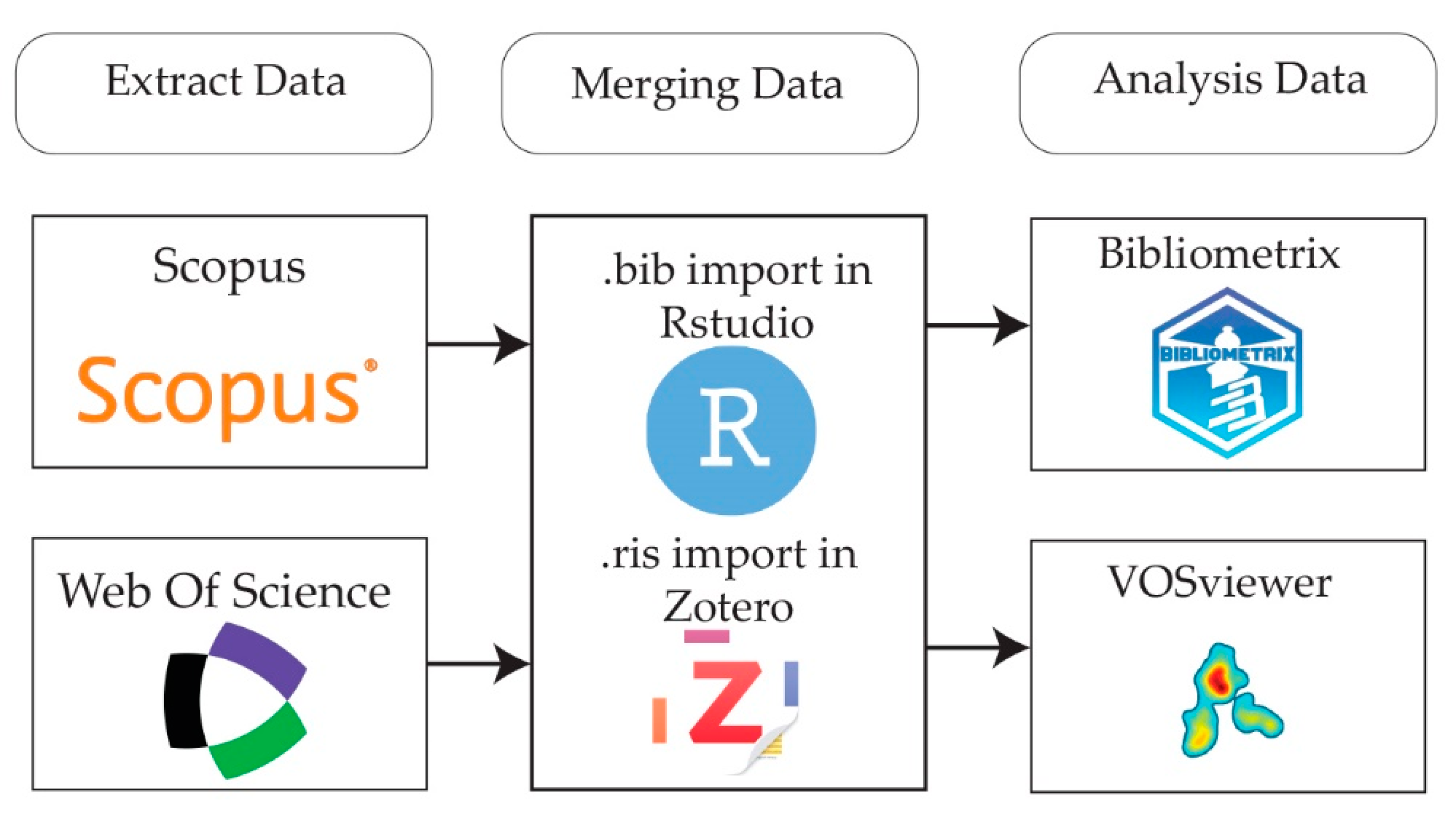
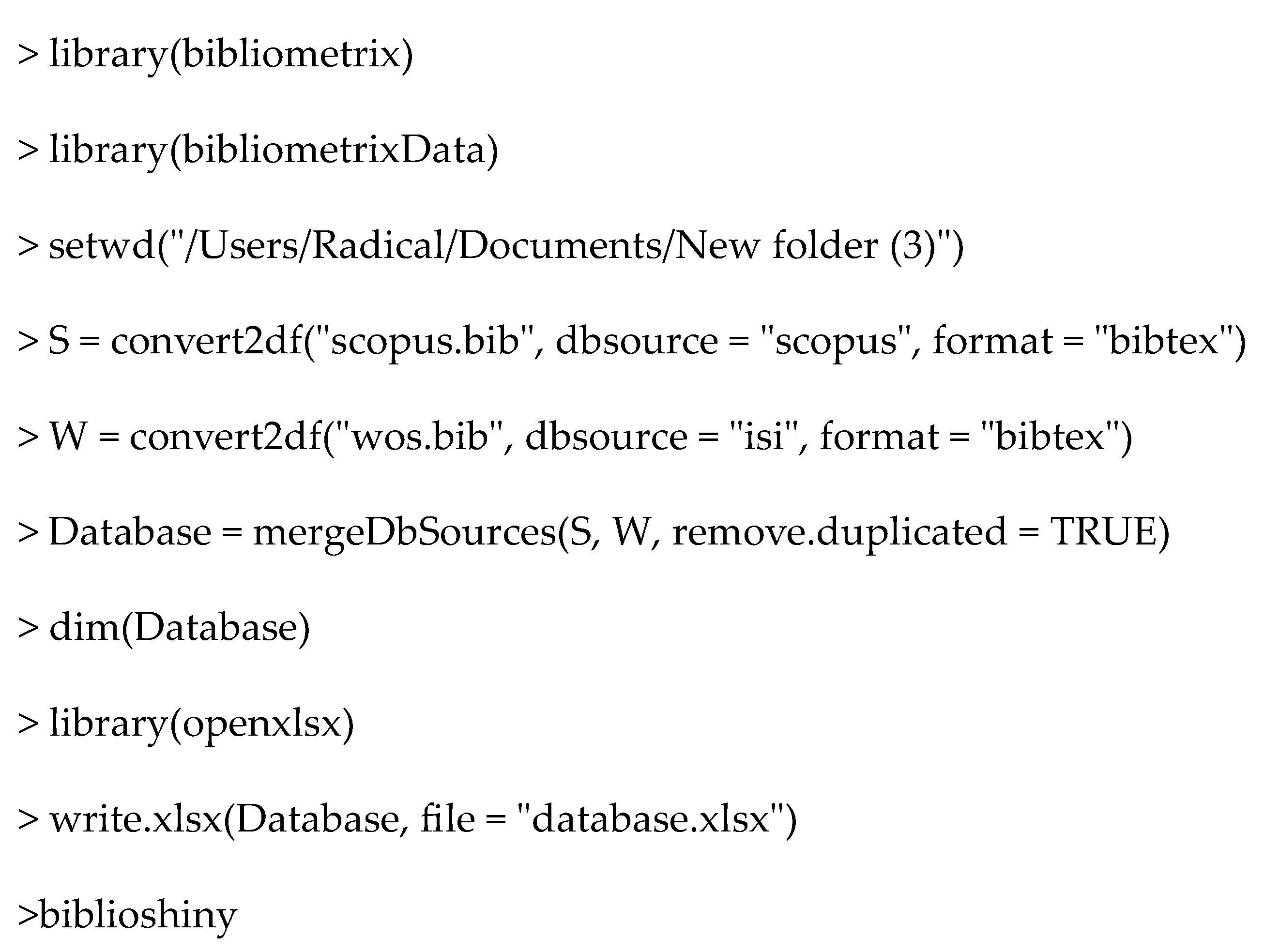
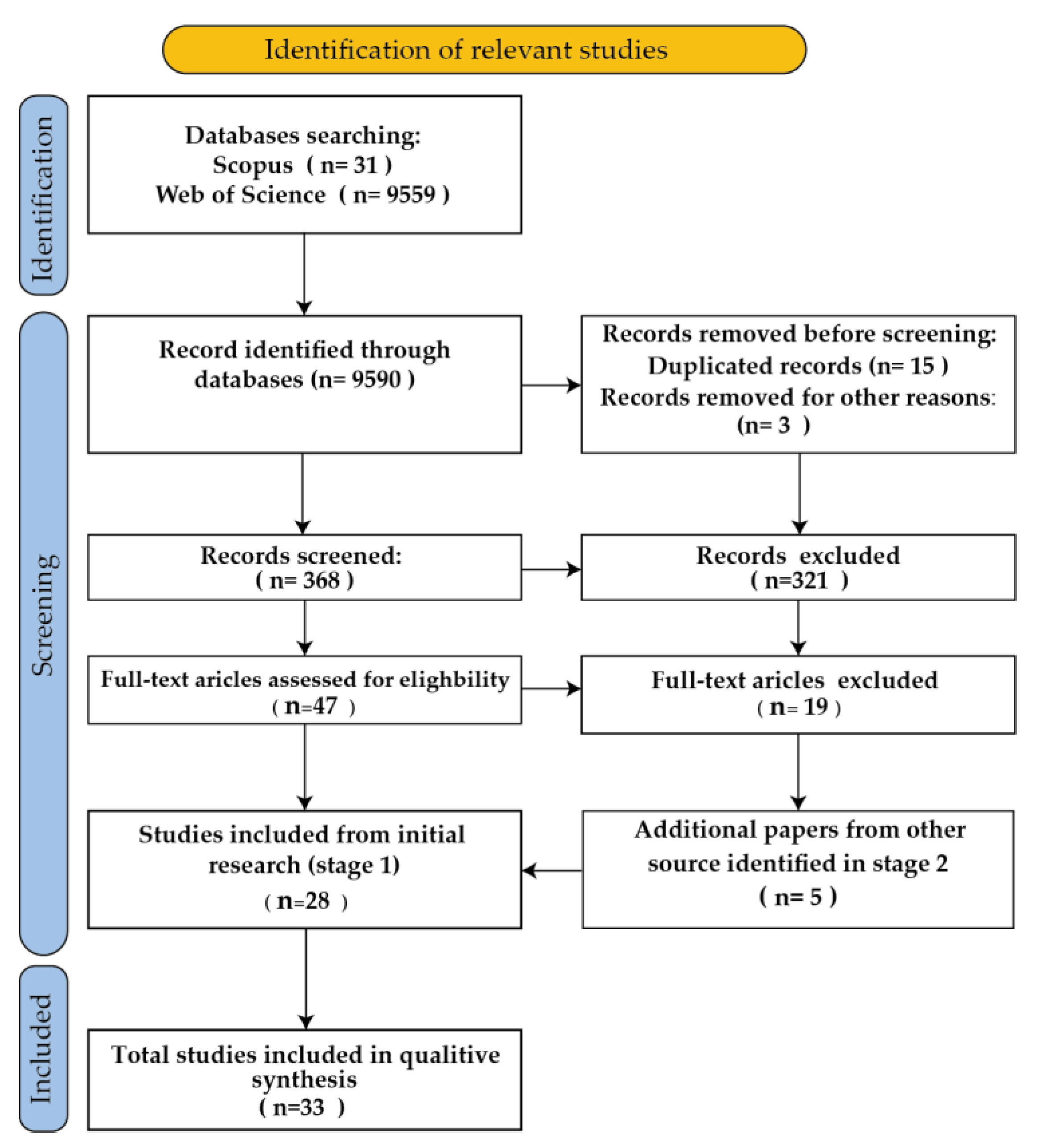
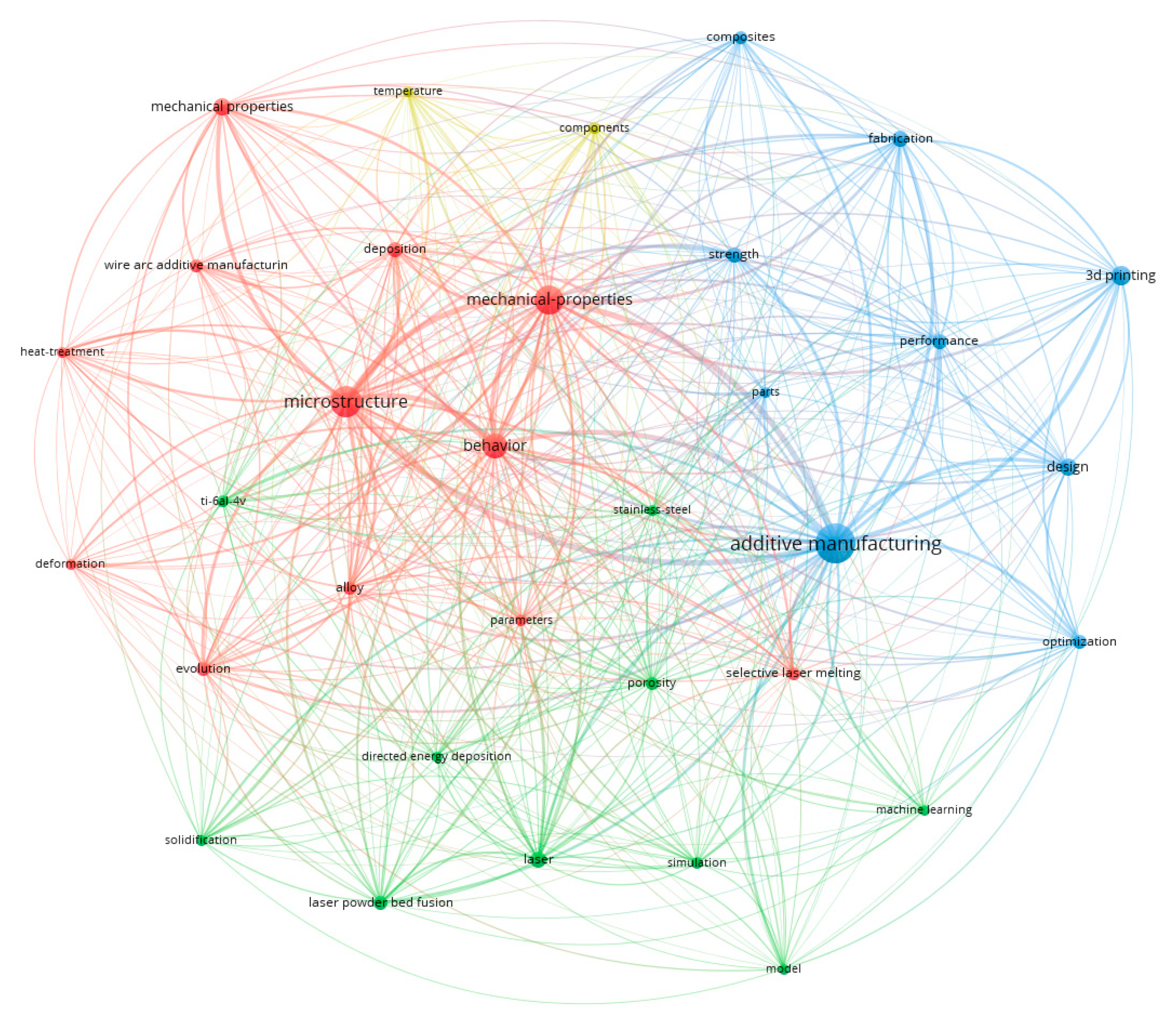
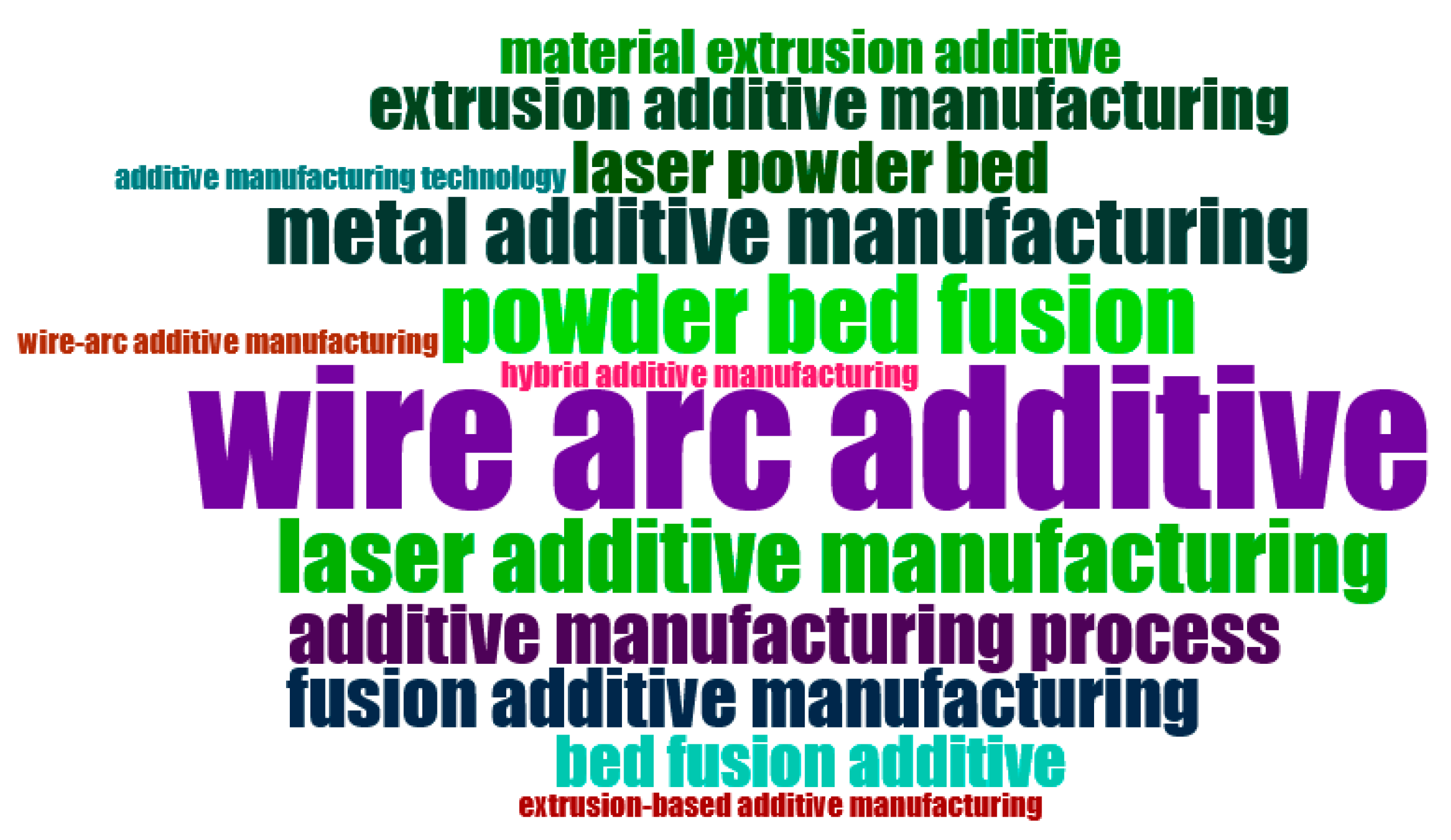
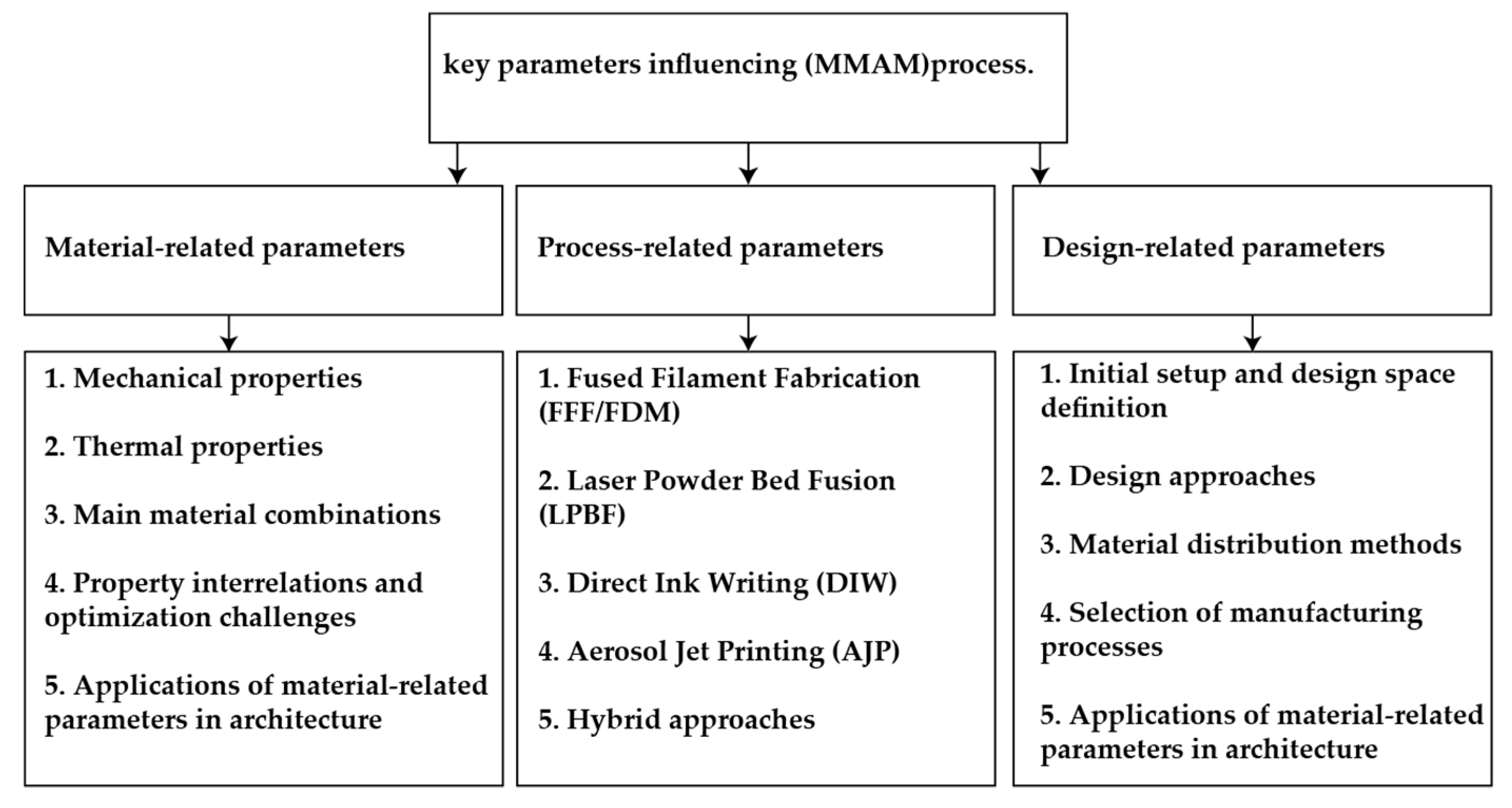



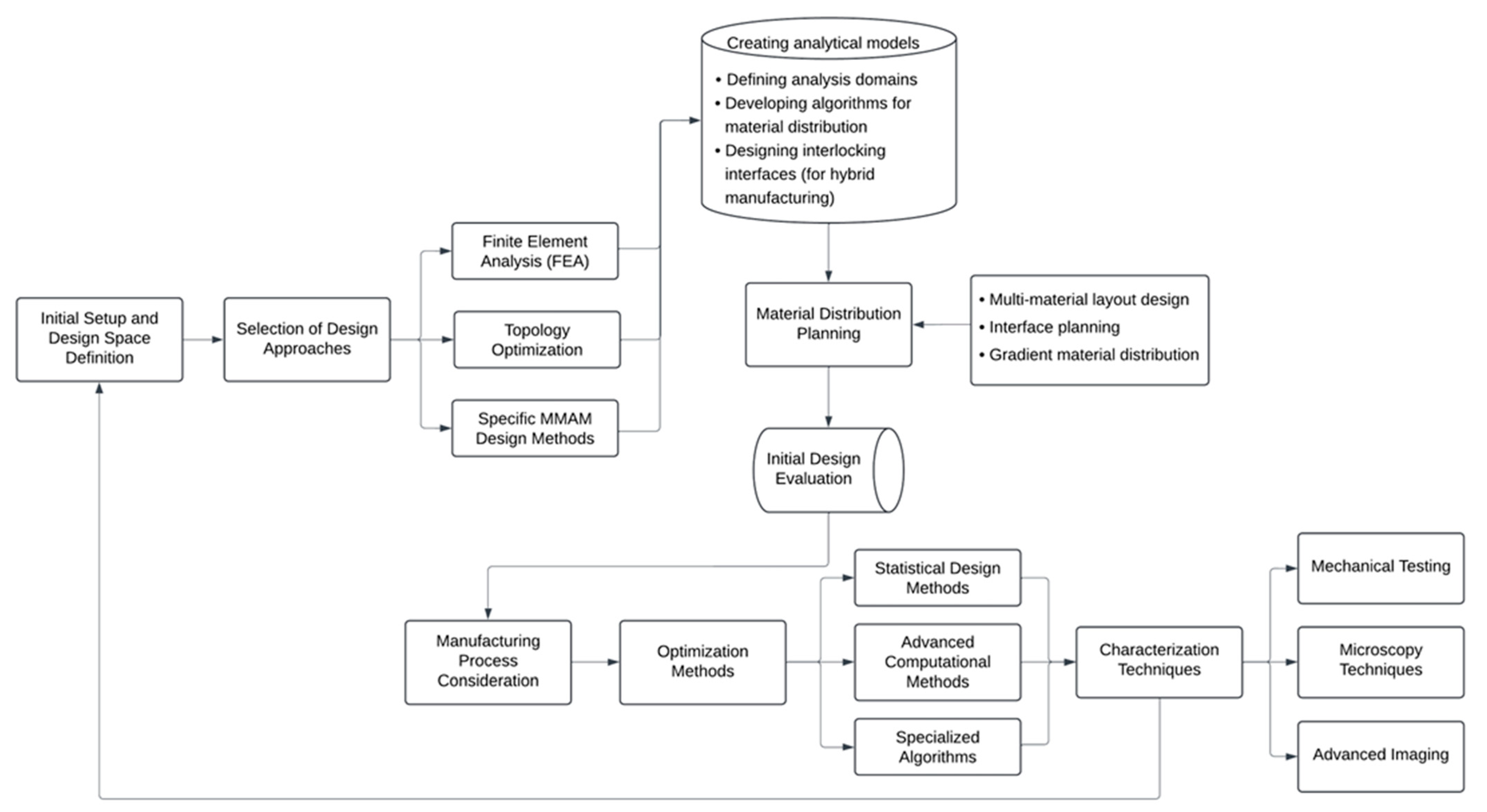
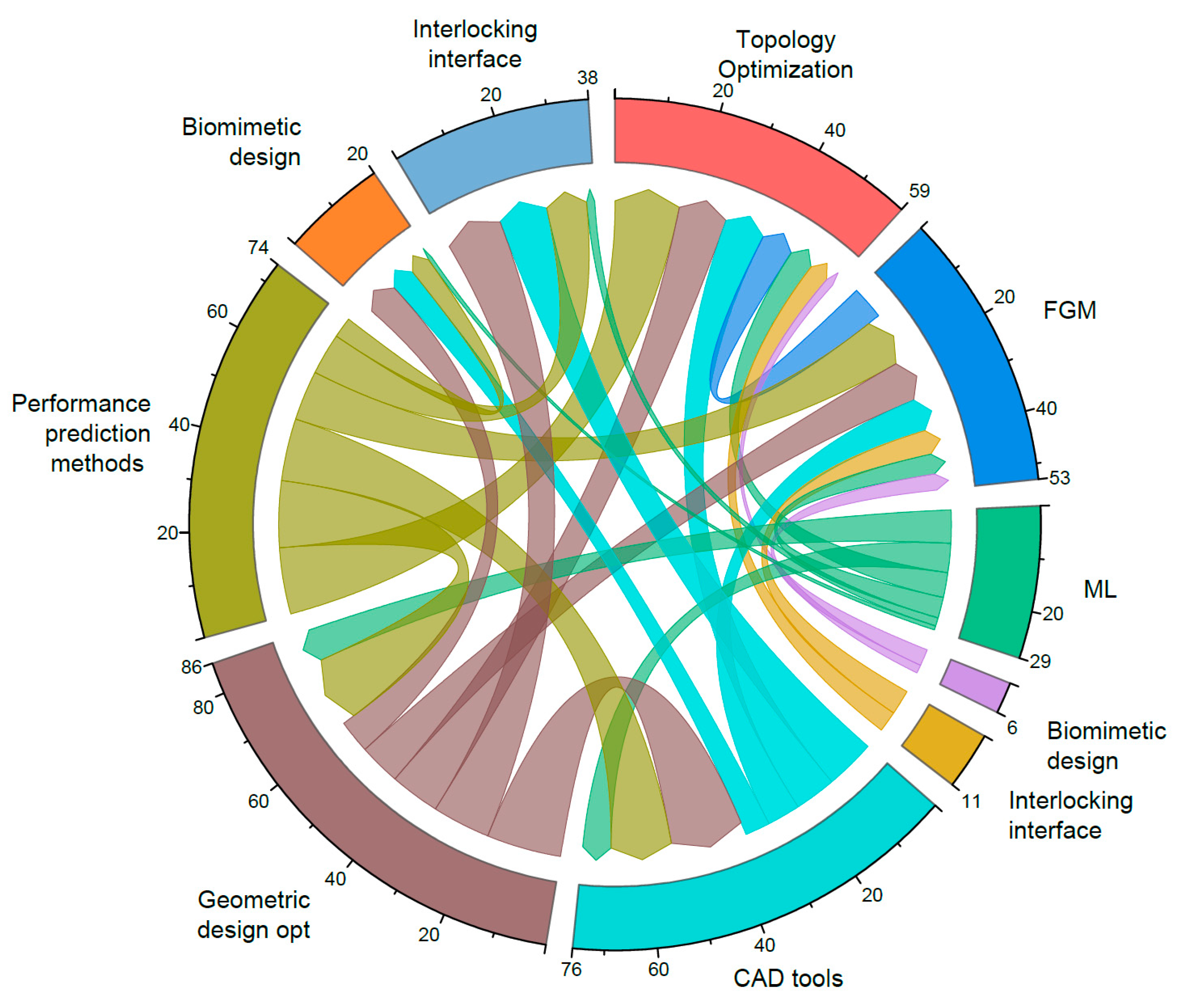
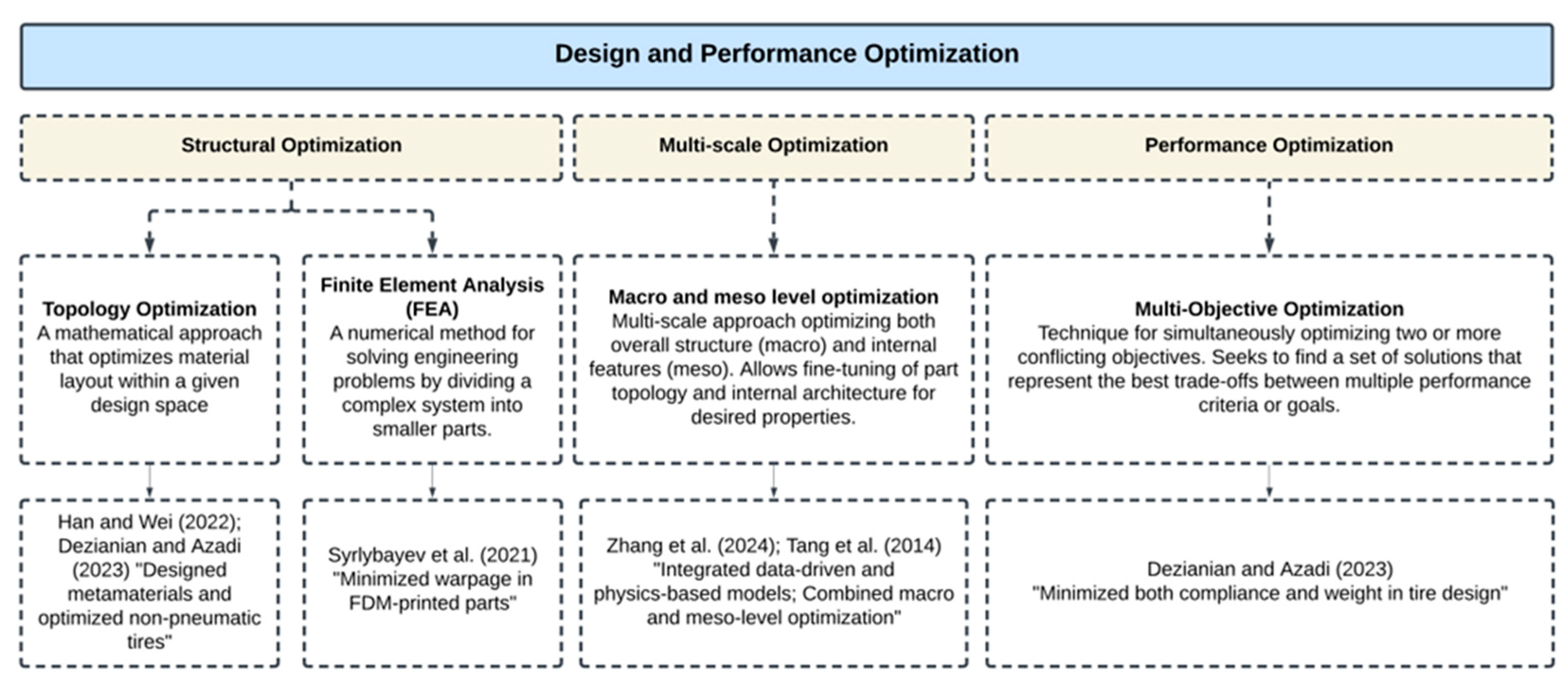



| No. | Item | Context |
|---|---|---|
| 1 | Population | Optimization techniques in MMAM in the building industry. |
| 2 | Interventions | All instances referring to the status of AM and MMAM. |
| 3 | Comparisons | FGM researchers, process and information technologies. |
| 4 | Outcomes | The role of AM in industry’s use of MMAM. |
| 5 | Study method | Quantitative and qualitative analysis. 1 |
| No. | Item | Content |
|---|---|---|
| 1 | Aim | |
| Key Objective | To establish contextual knowledge relating to AM- MMAM through the analysis and classification of articles. | |
| 2 | Research Questions | |
| Main Question | Is there a need for a comprehensive optimization framework, the integration of data-driven approaches, and real-time monitoring in MMAM? | |
| Sub-questions | How can new construction technologies be introduced to industry? What are the optimized integration methods for AM and MMAM? | |
| 3 | Search Methods | |
| Electronic Databases | Scopus; Web of Science | |
| 4 | Selection | |
| Scopus String | (TITLE-ABS-KEY (“Additive manufacturing”) OR TITLE-ABS-KEY (“rapid prototyping”) AND TITLE-ABS-KEY (“Functionally graded materials”) OR TITLE-ABS-KEY (“Direct digital manufacturing”) AND TITLE-ABS-KEY (“Functionally graded materials”) OR TITLE-ABS-KEY (“gradient materials”) OR TITLE-ABS-KEY (“multi material”) OR TITLE-ABS-KEY (“Process optimization”) OR TITLE-ABS-KEY (“function optimization”) OR TITLE-ABS-KEY (“functional optimization”) OR TITLE-ABS-KEY (“performance optimization”) OR TITLE-ABS-KEY (“mechanical optimization”) OR TITLE-ABS-KEY (“thermal optimization”) OR TITLE-ABS-KEY (“optimization”) AND TITLE-ABS-KEY (“Fused deposition modeling”) OR TITLE-ABS-KEY (“fused filament fabrication”) OR TITLE-ABS-KEY (“material extrusion”) OR TITLE-ABS-KEY (“layer extrusion printing”)) AND PUBYEAR > 2019 AND PUBYEAR < 2026 | |
| Web of Science String | “ADDITIVE MANUFACTURING” (Title) OR “rapid prototyping” (Title) OR “direct digital manufacturing” (Title) AND “functionally graded materials” (Title) OR “gradient materials” (Title) AND “multi material” (Title) OR “multiple materials” (Title) AND “process optimization” (Title) OR “function optimization” (Title) AND “functional optimization” (Title) AND “performance optimization” (Title) OR “mechanical optimization” (Title) OR “thermal optimization” (Title) OR “optimization” (Title) AND “fused filament fabrication” (Title) OR “material extrusion” (Title) OR “layer extrusion printing” (Title) and 2021 or 2022 or 2023 or 2024 or 2025 (Publication Years) and Article (Document Types) | |
| Idiom | English | |
| 5 | Exclusion criteria | |
| Not related to AMMM or AM. | ||
| Abstract not available for download. | ||
| Not written in the defined idiom. | ||
| 6 | Search Method | |
| Data Extraction | Use R software to preserve the integrity of data and monitor status based on the protocol. | |
| Narrative Synthesis | Bibliometric analysis: Publications over time; Methodology applied. Thematic analysis: Analysis of selected publications; Description of findings, outcomes and relationships. |
| Property Type | Property/Combination | Influence on MMAM | Key Study |
|---|---|---|---|
| Mechanical | Young’s modulus | Affects part stiffness and deformation | [5] |
| Mechanical | Tensile strength | Influences load-bearing capacity and durability | [6] |
| Mechanical | Flexural properties | Impacts bending behavior and structural integrity | [7] |
| Mechanical | Hardness | Affects wear resistance and surface quality | [8] |
| Mechanical | Rheological properties | Influences printability, layer adhesion, and part quality | [8] |
| Mechanical | Interfacial bonding | Affects part integrity and performance | [9] |
| Thermal | Thermal conductivity | Affects heat distribution and dissipation during printing | [10] |
| Thermal | Thermal expansion coefficient | Critical for managing residual stresses and warping | [4] |
| Thermal | Melting point | Affects material behavior during printing | [11] |
| Thermal | Glass transition temperature | Impacts material flow and layer adhesion | [11] |
| Material Combinations | Polymer–polymer | Balances properties like strength and flexibility | [11] |
| Material Combinations | Metal–metal | Optimizes mechanical properties and processability | [10] |
| Material Combinations | Polymer–composite | Enhances base polymer properties | [9] |
| Material Combinations | Metal–polymer | Influences material behavior at molecular/microscopic level | [12] |
| Scale-Dependent | Micro-scale properties | Influences material behavior at molecular/microscopic level | [13] |
| Scale-Dependent | Macro-scale properties | Determines bulk properties observable at macroscopic level | [6] |
| Study | Initial Setup/ Design Space | Design Approach | Manufacturing Process | Optimization/ Design Process | Characterization Method |
|---|---|---|---|---|---|
| Giubilini and Minetola [41] | The analytical model of a reentrant auxetic structure. | Topology optimization for auxetic structures | Fused Filament Fabrication (FFF) | - | Dimensional analysis using CT scan |
| Dezianian and Azadi [42] | Problem defined in MATLAB code. | Topology optimization for non-pneumatic tire | Laser Powder Bed Fusion (LPBF) | Optimization steps | Compression tests |
| Liu et al. [16] | Analysis domain of the compliant finger. | Multi-material topology optimization for compliant mechanisms | Fused Filament Fabrication (FFF) | Topology optimization results for single-material and bi-material designs | Tensile tests |
| Englert et al. [19] | Setup for manufacturing hybrid LPBF-FFF specimens. | Design of interlocking interfaces for hybrid manufacturing | Hybrid LPBF–FFF | Various interlocking geometries and their fabrication paths | Tensile tests, shear tests, and μCT analysis |
| Suescun Gonzalez et al. [13] | Global framework of the study. | Direct recycling and printing of multi-material waste | Fused Granular Fabrication (FGF) | - | FTIR, DSC, MFI, density measurements, and tensile tests |
| Han and Wei [20] | Principle for introducing numerical homogenization method | Alternating Active Phase and Objective (AAPO) algorithm for multi-material topology optimization | Multi-material Fused Deposition Modeling (FDM) | Topology optimization results for different parameter settings | Poisson’s ratio and thermal expansion experiments, FEA verification |
| Wang et al. [11] | Schematic diagrams of component proportions. | Machine learning prediction of hardness for multi-material blends | Fused Filament Fabrication (FFF) with custom mixing nozzle | Machine learning model optimization and comparison | Shore hardness measurements, machine learning prediction validation |
| Khan et al. [31] | FFF 3D printer and tensile test samples. | Full factorial design of experiments, ANOVA analysis | Fused Filament Fabrication (FFF) | Optimization of FFF processing parameters. | Tensile testing, SEM, and optical microscopy |
| Xu et al. [21] | Heat structures including heating and radiation, and assembly fastening form in RP. | Electrothermal response optimization of nozzle structure for multi-material RP based on fuzzy adaptive control | Fused Deposition Modeling (FDM) | (a) Iterative optimal value of C and calculation of RSS; (b) different α and corresponding minimum RSS | Thermal–solid coupling finite-element analysis, physical experiments measuring temperature change and material extrusion loading |
| Design Methods | Description | Methodology | Example References |
|---|---|---|---|
| Topology optimization | Method to optimize material distribution within a given design space for improved performance while satisfying given constraints [4]. | Uses algorithms to iteratively remove or redistribute material based on stress analysis, often employing finite-element analysis (FEA) to evaluate designs [5,6,38]. | Liu et al. [16], Han and Wei [20], Dezianian and Azadi [42]. |
| Functionally graded material design | Creating components with spatially varying composition or structure for specific performance gradients [3]. | Involves designing continuous or stepwise variations in material composition or properties across a part, often using parametric modeling or optimization algorithms [15]. | Han and Wei [20]. |
| Biomimetic design | Employing engineering solutions based on nature’s structures and processes to solve technical problems [13]. | Analyzes and mimics structures and mechanisms found in nature, often involving reverse engineering of biological systems and adapting them to engineering problems [24]. | Wang et al. [11]. |
| Interlocking interface design | Creating companion geometries at material interfaces to enhance bond strength and component integrity in multi-material structures [11]. | Designs specific geometric features at material interfaces to improve mechanical interlocking, often using CAD modeling and FEA to optimize interface geometry [11]. | Englert et al. [19], Cecil et al. [29], Teawdeswan and Dong [14]. |
| Geometric design optimization | Optimizing part geometry to improve performance or meet specified criteria, often focusing on specific features or overall shape [40]. | Uses parametric design and optimization algorithms to adjust geometric features, often in conjunction with FEA or other performance simulation methods [40]. | Giubilini and Minetola [41], Alsharif et al. [40], Zhang et al. [28]. |
| CAD modeling | Using computer-aided design software to create and modify complex MMAM designs, enabling precise control over part geometry and material distribution [27]. | Employs 3D modeling software to create digital representations of parts, often incorporating parametric design features for easy modification and optimization [18,27]. | Quero et al. [23], Cecil et al. [29]. |
| Performance prediction methods | Utilizes methods like finite-element analysis (FEA) and computational fluid dynamics (CFD) to simulate part performance under various conditions [7]. | Using computational techniques to predict component behavior and properties, enabling virtual testing and optimization [7,28]. | Zhang et al. [28], Wang et al. [30]. |
| Machine learning | Utilizing artificial intelligence algorithms to optimize design parameters, predict material properties, and enhance overall performance in MMAM [41]. | Employs various ML algorithms (e.g., neural networks, genetic algorithms) to analyze large datasets of design parameters, material properties, and performance metrics. Can be used for inverse design, property prediction, and process optimization [26]. | Wang et al. [30], Teawdeswan and Dong [14], Zhang et al. [28]. |
| Distribution Strategy | Characteristics | Key Design Considerations | Aligned Design Approaches | Schematic Figures of Material distribution Schemes | References |
|---|---|---|---|---|---|
| Discrete Material Distribution | Clear material boundaries | Core–shell structures; Layer-wise alternation; Voxel-based methods | Topology optimization, Geometric design optimization |  | [21,26,34,44,45] |
| Gradient Material Distribution | Spatially varying composition | Functional gradients; Stimuli-responsive; Biological gradients | Functionally graded material design |  | [44] |
| Hybrid Distribution Approaches | Combination of discrete and gradient | Controlled blending; Variable density printing | Biomimetic design, Complex material distributions |  | [40] |
| Temporal Distribution (4D Printing) | Time-dependent functionality | Smart materials; Shape-changing materials | Geometric design optimization, Biomimetic design |  | [46] |
| Process | Key Capabilities | Limitations/Challenges | References |
|---|---|---|---|
| FFF |
|
| [31,34,39] |
| LPBF |
|
| [26,33] |
| DIW |
|
| [23,40] |
| AJP |
|
| [28] |
| Process | Testing Category | Testing Method | References |
|---|---|---|---|
| FFF/FDM | Mechanical | Tensile testing, compression, flexural testing, hardness testing | [23,27,42] |
| FFF/FDM | Microstructural | SEM, optical microscopy | [35,52] |
| FFF/FDM | Non-destructive | X-ray Computed Tomography (X-CT) | [53] |
| FFF/FDM | Application-specific | pH responsiveness testing, shape memory tests | [28,52] |
| FFF/FDM | Statistical | ANOVA and regression analysis, error analysis (R², MSE, MAE) | [28,35] |
| LPBF | Mechanical | Microhardness and nanoindentation tests, three-point bending tests | [25,31] |
| LPBF | Microstructural | SEM, XRD, TEM, EDS | [25,31] |
| LPBF | In situ | optical monitoring | [28] |
| LPBF | Process-specific | Melt pool modeling | [33] |
| DIW | Functional | Electrical resistance measurements, conductivity detection | [42] |
| DIW | Process-specific | Optimization of printing parameters (nozzle size, extrusion rate, printing speed) | [43] |
| DIW | Application-specific | ECG signal monitoring | [43] |
| Aspect | Current Methods | Proposed Improvements |
|---|---|---|
| Manufacturing Tools | Most approaches are limited to homogeneous materials, primarily focusing on the load-bearing capacity of printed objects. | Adaptive printing speed and layer thicknesses to balance efficiency and quality. |
| Process Control | Basic material flow control with limited changes in ratios. Manual parameter adjustments based on visual inspection. Limited real-time monitoring capabilities. | Scale-up of Zhang et al.’s adaptive process control methods for building construction-scale applications [28]. Implementation of real-time feedback systems during construction [25]. |
| Design Integration | Basic topology optimization. Separate structural and environmental performance considerations. Limited material property customization. | Simulation software for optimizing material distribution across multiple scales. Digital twin technologies based on Wang et al.’s AI-driven methods. |
| Digital Tools | Basic simulation models with limited multi-material capabilities. Separate design and manufacturing digital workflows. | Complex process parameter optimization. Requires advanced control systems. Challenges in scalability. |
| Interdisciplinary Integration | Limited integration between material selection and process parameters. Separate material and performance optimization. | Comprehensive consideration of material, process, and design parameters. Complete integration of design and manufacturing approaches. |
| Key Findings | Implications for Future Research in the Construction Industry | Related Studies |
|---|---|---|
| Topology optimization for efficient material distribution | Integrate with material selection algorithms | [20,21,42] |
| Multi-scale design considerations necessary | Develop multi-scale optimization approaches | [20,21,56] |
| Process parameters significantly influence part quality | Develop standardized optimization procedures | [23,31,32,39] |
| AI optimizes MMAM processes and predicts properties | Develop real-time AI control systems | [15,28,38] |
| Functionally graded materials achievable through design | Advance design methodologies for property gradients | [20,21,42,57] |
| Interfacial properties crucial for design and performance | Enhance interface design and characterization | [13,19,31,39] |
| Simulation crucial for process and design optimization | Advance multiphysics modeling techniques | [20,32,33] |
| Feeding mechanisms expand design possibilities | Develop advanced material delivery systems | [23,34] |
Disclaimer/Publisher’s Note: The statements, opinions and data contained in all publications are solely those of the individual author(s) and contributor(s) and not of MDPI and/or the editor(s). MDPI and/or the editor(s) disclaim responsibility for any injury to people or property resulting from any ideas, methods, instructions or products referred to in the content. |
© 2025 by the authors. Licensee MDPI, Basel, Switzerland. This article is an open access article distributed under the terms and conditions of the Creative Commons Attribution (CC BY) license (https://creativecommons.org/licenses/by/4.0/).
Share and Cite
Fakhr Ghasemi, A.; Pinto Duarte, J. A Systematic Review of Innovative Advances in Multi-Material Additive Manufacturing: Implications for Architecture and Construction. Materials 2025, 18, 1820. https://doi.org/10.3390/ma18081820
Fakhr Ghasemi A, Pinto Duarte J. A Systematic Review of Innovative Advances in Multi-Material Additive Manufacturing: Implications for Architecture and Construction. Materials. 2025; 18(8):1820. https://doi.org/10.3390/ma18081820
Chicago/Turabian StyleFakhr Ghasemi, Amirhossein, and Jose Pinto Duarte. 2025. "A Systematic Review of Innovative Advances in Multi-Material Additive Manufacturing: Implications for Architecture and Construction" Materials 18, no. 8: 1820. https://doi.org/10.3390/ma18081820
APA StyleFakhr Ghasemi, A., & Pinto Duarte, J. (2025). A Systematic Review of Innovative Advances in Multi-Material Additive Manufacturing: Implications for Architecture and Construction. Materials, 18(8), 1820. https://doi.org/10.3390/ma18081820







